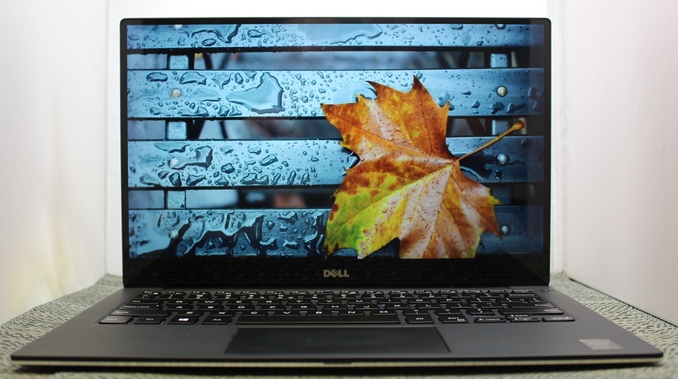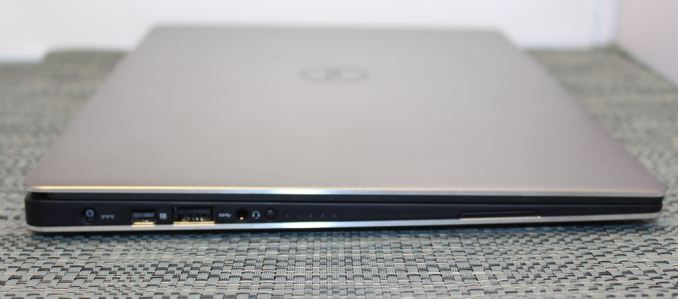Dell XPS 13 Review
by Brett Howse on February 19, 2015 9:00 AM EST- Posted in
- Laptops
- Dell
- Ultrabook
- Broadwell-U
- XPS 13

Dell launched the 2015 version of their XPS 13 at CES in January, and it made a big impression because of something that was very small. The first thing you see when you look at the XPS 13 is how small the bezels are around the display. At 5.2 mm, they are easily the thinnest display bezels on any laptop made today. Dell claims the XPS 13 is a 13 inch display in the chassis of an 11 inch notebook, and while they have made that claim before, for 2015, it would be hard to argue with them. But the XPS 13 is more than just a display, and Dell has outfitted it with some very modern hardware to give us our first look at an Ultrabook based on the just launched Intel 5th Generation processors, Broadwell-U.
At CES, Dell also told me that the new XPS 13 would have great battery life, with the company claiming that it would get up to fifteen hours. That claim seems hard to believe, with our battery life test topped at just a hair under ten hours by the current leader, the MacBook Air 13. However, this will be our first look at a laptop running on the new 14 nm process from Intel, so we can get a chance to see just how power efficient the new processors are.
Dell is offering quite an arrangement of options as well, allowing the new XPS 13 to fit into a lot more budgets than some of the other premium notebooks around. The base model comes with the Intel Core i3-5010U processor, but if you need more speed you can upgrade to the i5-5200U or i7-5500U. All of the storage options are solid state drives, which is great to see. The base is 128GB, and optional upgrades are to 256GB or 512GB. Memory choices are dual-channel 4GB DDR3L-RS-1600, or a dual-channel 8GB option.
We received two models for testing, with the first being a Core i5-5200U with the 1920x1080 non-touch display, 4GB of memory, and a 128GB SSD, which lists for $900. The second model is the Core i5-5200U, with 2x4GB of memory, a 256GB SSD, and the 3200x1800 touch display. This model lists at $1400.
Update: Originally I had listed the 4 GB model as single channel, but it is actually 2 x 2 GB for dual channel. Sorry for the mistake.
| Dell XPS 13 9343 Specifications | |
| Processor | Intel Core i3-5010U (Dual-core + HT 2.1GHz 3MB L3 14nm 15W TDP) Intel Core i5-5200U - model tested (Dual-core + HT 2.2-2.7GHz 3MB L3 14nm 15W TDP) Intel Core i7-5500U (Dual-core + HT 2.4-3.0GHz, 4MB L3, 14nm, 15W TDP) |
| Chipset | Broadwell-ULT |
| Memory | 2 x 2GB or 2 x 4GB DDR3L-RS-1600 (Dual Channel 8GB Max) |
| Graphics | Intel HD 5500 (23 EUs at 300-900MHz on Core i3) (24 EUs at 300-900MHz on Core i5) (24 EUs at 300-950MHz on Core i7) |
| Display | 13.3" Anti-Glare IPS 16:9 FHD (1920x1080) (Sharp 1420 Panel) 13.3" Glossy IPS 16:9 QHD+ (3200x1800) IGZO2 (Sharp 1421 Panel with Corning Gorilla Glass NBT and Touchscreen) |
| Storage | 128GB/256GB/512GB SSD (Samsung PM851 M.2 2280) |
| Optical Drive | N/A |
| Networking | Dell Wireless 1560 plus Bluetooth 4.0 - model tested (2x2:2 802.11ac 867Mbps capable Broadcom) Intel Dual Band Wireless-AC 7265 plus Bluetooth 4.0 (2x2:2 802.11ac 867Mbps capable) Intel Dual Band Wireless-N 7265 plus Bluetooth 4.0 (2x2:2 802.11n 300Mbps capable) |
| Audio | Realtek HD Stereo Speakers professionally tuned with Waves MaxxAudio Pro 1w x 2 Headset jack |
| Battery/Power | 52Wh non-removable 45W Max AC Adapter |
| Front Side | Charge Light |
| Left Side | Headset Jack Battery Meter 1 x USB 3.0 with PowerShare 1 x mini DisplayPort Speaker AC Power Connection |
| Right Side | Noble Lock Slot 1 x USB 3.0 with PowerShare SD Card Slot Speaker |
| Back Side | N/A |
| Operating System | Windows 8.1 64-bit |
| Dimensions | 11.98" x 7.88" x 0.33-0.6" (WxDxH) (304mm x 200mm x 9-15mm) |
| Weight | 2.6 lbs (1.18kg) Non-Touch 2.8 lbs (1.27kg) Touch |
| Extras | 720p HD Webcam Backlit Keyboard |
| Colors | Silver |
| Pricing | $800 (i3, 4GB, 128GB, FHD) $900 (i5, 4GB, 128GB, FHD) - model tested $1000 (i5, 8GB, 128GB, FHD) $1300 (i5, 8GB 128GB, QHD+) $1400 (i5, 8GB, 256GB, QHD+) - model tested $1600 (i7, 8GB, 256GB, QHD+) $1900 (i7, 8GB, 512GB, QHD+) |
The display has some choices as well. The base model comes with a 13.3 inch 1920x1080 IPS display, with a matte finish, and no touch capabilities. This is still a respectable 165 pixels per inch, and is a good option to keep the costs down. The upgraded display is quite the upgrade. Dell has worked with Sharp to outfit the XPS 13 with an optional 3200x1800 resolution IGZO panel, which features Corning Gorilla Glass NBT over the top, along with ten-point multitouch. This works out to 272 pixels per inch, and the IGZO panel is a full RGB stripe.
There are a couple of other options as well, such as a range of wireless adapters, with the Dell 1560 outfitted on the review laptops that we received. This is a Broadcom wireless adapter, with 802.11ac support. Some of the options, like the 512GB drive, are only available with the top CPU and upgraded display. Dell does offer some degree of flexibility when ordering, but not all options are available for all devices.
Dell has crafted a fine looking laptop, with some new parts from Intel and Sharp paving the way. On paper this is a great start, so let's get into the finer details.











201 Comments
View All Comments
shadarlo - Tuesday, March 3, 2015 - link
I have worked on this laptop and it is truly a beautiful piece of technology. I got it just a few weeks after it initially launched for a co-worker. Set it up and loved it. Hated to part with it. I was carrying it all over the office and even non techie people were wanting to touch it and hold it due to it's tiny size yet huge screen.Combined with a relatively low price for this type of unit with an included SSD and this is a no-brainer for any typical business user. I can't imagine why you'd want any other laptop unless you simply need more power, but very few business users do these days.
sporkloudly - Friday, April 10, 2015 - link
But you didnt have any issues with the keyboard noise that people are reporting in the forums?djscrew - Tuesday, March 3, 2015 - link
Are you sure you can't disable the auto brightness? I found it unintuitive but I was able to figure out how to do it in the battery settings of my previous generation XPS 13FranC - Friday, March 6, 2015 - link
Just curious Brett, with the adaptive brightness enabled, how were you able to calibrate the display to get your results? I recently shipment of this otherwise great laptop on March 4 and using Xrite's i1Profiler have not been able to get a decent color profile made (yes, I've 'disabled' adaptive brightness in all the typical places.) Would it be possible to please ping Dell again, since your request would carry more weight than hundreds of us regular folk?! Thanks!Brett Howse - Saturday, March 7, 2015 - link
I was not able to calibrate the display, I was only able to read the stock results due to the Content Adaptive Brightness Control, and not by our standard means. I spoke to Dell just yesterday and they still do not have a solution to this issue yet.JoJ - Sunday, March 8, 2015 - link
Couldn't you just find the light sensor and put some duct tape or even better optical sealing tape from a photo repair supply, over the darn thing?Would that not solve any variability??
FranC - Sunday, March 8, 2015 - link
Thanks for the update, Brett. Hopefully Dell is actively working on a solution, even if it negatively impacts battery life.JoJ, the adaptive brightness is not based on ambient light level, but on the content of what data is being displayed on the screen. In the case of running display calibration/profiling software, after setting the initial brightness level, each color patch is displayed on screen and read back by a spectro/colorimeter. Any variation in brightness during this process results in creation of a bogus color profile.
JoJ - Sunday, March 8, 2015 - link
Dell are missing a huge trend to carrying smaller kit in professional photography if they don't fix this brightness issue. I think this is holding back a lot of sales right now. I was going to go for the FHD as a coding and writing machine but this review suggested to me that the QHD might calibrate very well given the out of any advantage being so much over the FHD model I'm looking out for faster M.2 drives and crossing my fingers for any kind of hack to calibrate the shiny new super res screen...Oh and oh for more RAM ... Dell just missed out on a blockbuster here?
JoJ - Sunday, March 8, 2015 - link
Out of box not out of any. auto typo sorry :'(growl - Sunday, March 22, 2015 - link
Is it possible to run the QHD screen at the lower 1080p resolution, and would this improve battery life? Or is that not at all how things work?